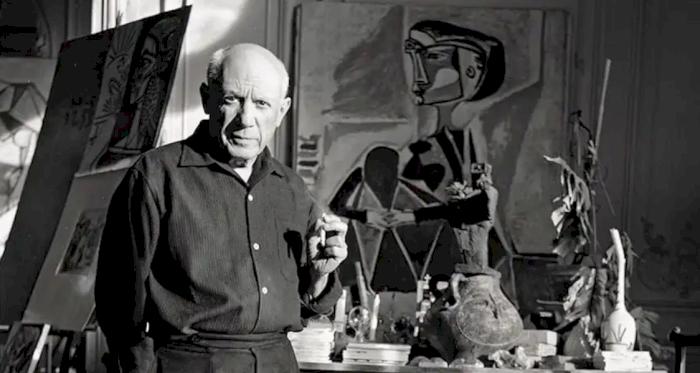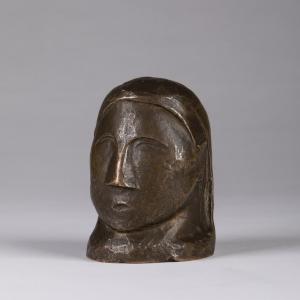Pablo Picasso (1881-1973)
Born in Andalusia, where he spent the first years of his life, Pablo Ruiz Picasso grew up in Barcelona, his father having been appointed professor at the School of Fine Arts. Picasso himself was admitted as a pupil at the age of 14, as he would be two years later at the Royal Academy in Madrid.
... After this period of classical studies, he discovered bohemian life, notably by frequenting an artistic and literary cabaret in Barcelona's old town, Els Quatre Gats, where his work was exhibited for the first time. At the same time, he frequented a brothel in Carrer D'Avinyo, which inspired one of his most famous paintings, Les Demoiselles d'Avignon. He also forged strong friendships, such as with Casagemas, whose suicide in 1901 left a deep impression on him. It was in depicting his dead friend that he discovered the emotional potential of blue cameo paintings.
From 1904 onwards, Picasso settled permanently in France, initially moving into a shabby studio in Montmartre, at the Bateau-Lavoir, the name given by Max Jacob because the building was reached by a bridge. It was in front of this studio that Picasso met Fernande Olivier in 1905. With her, he met artists, writers such as Gertrude Stein, and poets, notably Guillaume Apollinaire. This happy period marked the beginning of his pink period, with his paintings of acrobats in muted colours.
In 1907, Picasso was working on the composition of Les Demoiselles d'Avignon when the great Cézanne retrospective was held in Paris. It was through the work of the painter from Aix-en-Provence that he became close to Georges Braque. Together, they devoted themselves to formulating cubism. But the declaration of war put an end to their collaboration, as Braque had to rejoin his regiment. At the age of 34, Picasso was alone in Paris and still virtually unknown.
In 1917, the Ballets Russes asked him to work on the costumes and sets for their next show. On his way to Italy to join the troupe, he met Olga, one of the Ballets' dancers, whom he married the following year. Their son Paul was born in 1921.
During this period of sentimental calm and prosperity, Picasso practised a ‘return to order’, i.e. a return to a classical form of art after the extreme attempts of the avant-gardes. However, from 1925 onwards, his work once again took on a surrealist quality. He returned to the search for new forms and devoted himself more and more to sculpture.
On 27 April 1937, a tragic event turned his career upside down. In Spain, the German air force, working for Franco's nationalists, bombed the small Basque town of Guernica. In response, Picasso painted the huge canvas that would be exhibited a month later in the Republican pavilion at the Paris International Exhibition. This work, conceived as ‘an instrument of war’, brought him closer to the Communist Party, of which he became a member.
At the end of the 1940s, he moved to Vallauris in Provence, where he began a new career as a ceramist. It was in this region that he produced his last works, including paintings, sculptures, terracottas and other heterogeneous objects. He moved successively to the Villa Californie in the Bay of Cannes, the Château de Vauvenargues at the foot of the Montagne Sainte-Victoire, and the mas de Notre-Dame de Vie in Mougins, places that his works have since made famous.
(biography collected from the centrepompidou.fr website)
From 1904 onwards, Picasso settled permanently in France, initially moving into a shabby studio in Montmartre, at the Bateau-Lavoir, the name given by Max Jacob because the building was reached by a bridge. It was in front of this studio that Picasso met Fernande Olivier in 1905. With her, he met artists, writers such as Gertrude Stein, and poets, notably Guillaume Apollinaire. This happy period marked the beginning of his pink period, with his paintings of acrobats in muted colours.
In 1907, Picasso was working on the composition of Les Demoiselles d'Avignon when the great Cézanne retrospective was held in Paris. It was through the work of the painter from Aix-en-Provence that he became close to Georges Braque. Together, they devoted themselves to formulating cubism. But the declaration of war put an end to their collaboration, as Braque had to rejoin his regiment. At the age of 34, Picasso was alone in Paris and still virtually unknown.
In 1917, the Ballets Russes asked him to work on the costumes and sets for their next show. On his way to Italy to join the troupe, he met Olga, one of the Ballets' dancers, whom he married the following year. Their son Paul was born in 1921.
During this period of sentimental calm and prosperity, Picasso practised a ‘return to order’, i.e. a return to a classical form of art after the extreme attempts of the avant-gardes. However, from 1925 onwards, his work once again took on a surrealist quality. He returned to the search for new forms and devoted himself more and more to sculpture.
On 27 April 1937, a tragic event turned his career upside down. In Spain, the German air force, working for Franco's nationalists, bombed the small Basque town of Guernica. In response, Picasso painted the huge canvas that would be exhibited a month later in the Republican pavilion at the Paris International Exhibition. This work, conceived as ‘an instrument of war’, brought him closer to the Communist Party, of which he became a member.
At the end of the 1940s, he moved to Vallauris in Provence, where he began a new career as a ceramist. It was in this region that he produced his last works, including paintings, sculptures, terracottas and other heterogeneous objects. He moved successively to the Villa Californie in the Bay of Cannes, the Château de Vauvenargues at the foot of the Montagne Sainte-Victoire, and the mas de Notre-Dame de Vie in Mougins, places that his works have since made famous.
(biography collected from the centrepompidou.fr website)

